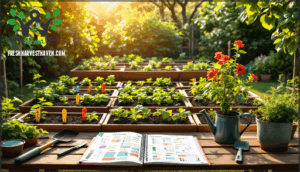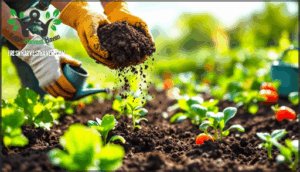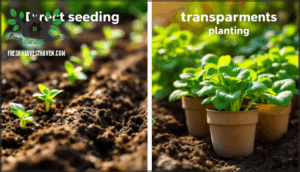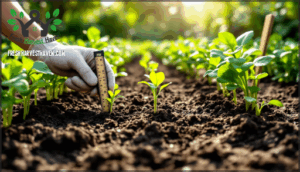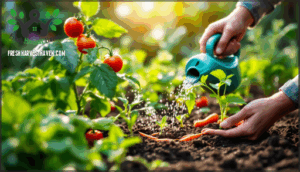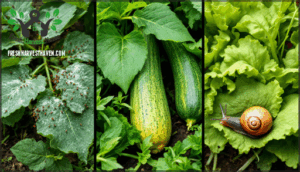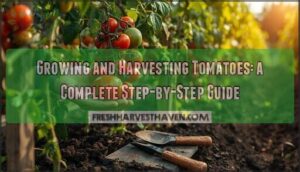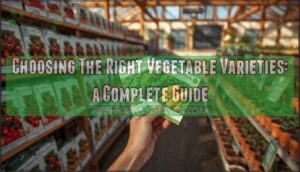This site is supported by our readers. We may earn a commission, at no cost to you, if you purchase through links.
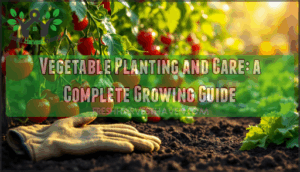
Growing your own vegetables transforms grocery bills, dinner plates, and even your relationship with food, but it all starts with understanding what each plant needs to thrive. From selecting varieties that match your climate to timing your waterings just right, every decision shapes your harvest.
Whether you’re working with a sprawling backyard or a sunny balcony, the fundamentals remain the same: good soil preparation, consistent care, and attention to what your plants are telling you.
Table Of Contents
- Key Takeaways
- Types and Classification of Vegetables
- Planning Your Vegetable Garden
- Preparing Soil and Planting Techniques
- Watering, Feeding, and Nutrient Management
- Pest, Disease, and Weed Control in Vegetables
- Frequently Asked Questions (FAQs)
- How often should I rotate crops?
- When should I start composting?
- What tools do I need for gardening?
- How do I preserve seeds for planting?
- Can I grow vegetables in containers?
- When is the best time to harvest vegetables?
- How do you store harvested vegetables properly?
- What are signs of overwatering or underwatering?
- How often should you prune vegetable plants?
- Can you grow vegetables in containers successfully?
- Conclusion
Key Takeaways
- Successful vegetable gardening hinges on matching plant varieties to your climate and soil conditions—disease-resistant and drought-tolerant cultivars can reduce infection rates by 90% and cut water needs by 25-40%, while climate-adapted varieties boost yields up to 30%.
- Soil preparation through reduced tillage, composting (10-20 tons per hectare), and smart fertilization following the 4R approach increases nutrient efficiency by 15-25% and cuts erosion by 50-90%, creating the foundation for healthy vegetable growth.
- Transplants offer significant advantages over direct seeding, delivering 15-25% better root development, 6-34% higher yields, and 99% establishment success compared to 70-85% for seeds, though they cost more upfront at $3-5 per plant.
- Integrated pest management combining weekly monitoring, crop rotation (which cuts rootworm numbers by 70%), natural predators, and physical barriers reduces chemical pesticide use by 40% while maintaining productive harvests.
Types and Classification of Vegetables
Before you start planting, it helps to know what kind of vegetables you’re working with. Different vegetables grow in different ways, and understanding these groups can make your garden planning a whole lot easier.
Let’s break down the main types you’ll encounter, from what grows underground to what thrives in certain seasons.
Root, Stem, Leaf, and Bulb Vegetables
Vegetables fall into distinct groups based on which part you harvest. Root vegetables like carrots and beets grow underground and pack serious carbohydrate energy—carrots deliver about 63 grams per 100 grams dry weight! Leafy greens such as spinach bring you protein and minerals, while stem vegetables like asparagus offer years of reliable harvests. Bulb vegetables, including onions and garlic, contain healthy fats and grow stronger each season.
Growth trends show roots and bulbs dominating farm revenue, so you’re planting real winners. To guarantee a successful harvest, remember that root crops prefer well-draining soil with a pH between 6.0 and 7.0.
Cruciferous, Allium, and Podded Varieties
Beyond roots and bulbs, three vegetable families bring powerful nutrient synergies to your garden. Cruciferous vegetables like broccoli and kale contain glucosinolates that support detoxification, while Allium vegetables—onions and garlic—deliver quercetin for heart health. Podded vegetables such as peas and beans fix nitrogen naturally, boosting soil fertility through smart crop rotation.
Here’s what makes each group special:
- Cruciferous varieties thrive in cool temps (15–21°C) and resist disease through hybrid genetic diversity
- Allium crops need well-drained soil with pH 6.0–7.0 for best bulb expansion
- Podded legumes require soil above 10°C to germinate and form nitrogen-fixing nodules
- Flavor profiles vary widely—from broccoli’s earthy bite to garlic’s sharp punch
- Culinary uses span from raw salads to hearty stews, maximizing kitchen adaptability
The brassica seed market is growing 7.5% annually through 2033, proving you’re planting what people want! These vegetables contain glucosinolate compounds, which contribute to their distinct flavors and potential health benefits.
Seasonal and Climate-Based Vegetable Choices
Matching vegetables to your climate zone and frost dates isn’t just smart—it’s the difference between bountiful harvests and frustrating failures. Cool-season crops like lettuce and peas love spring temperatures between 10–20°C, while summer vegetables such as tomatoes and peppers need 21–29°C to thrive.
Your regional varieties and microclimate gardening strategies determine what grows best, from winter vegetables in frost-free zones to succession planting throughout seasonal availability windows.
Planning Your Vegetable Garden
Planning a vegetable garden isn’t just about tossing seeds in the dirt and hoping for the best. You’ve got to think ahead about what you’re planting, where it’s going, and how you’ll set things up for success.
Let’s walk through the key decisions that’ll help your garden thrive from the start.
Selecting Suitable Vegetable Varieties
Think of picking vegetables like assembling a winning team—you need players suited to the job. Your choices should reflect climate adaptability, soil compatibility, and maturity rates that match your growing conditions. Disease-resistant varieties can slash infection rates by up to 90%, while drought-tolerant cultivars maintain productivity with 25–40% less water.
Match vegetable varieties to your local climate, and you’ll boost yields by up to 30% compared with non-adapted types.
- Cold-hardy spinach and lettuce extend your season by 4–6 weeks in temperate zones
- High-yield cherry tomatoes and zucchini deliver 10–15 pounds per square yard when conditions are right
- Fast-maturing radishes and lettuce complete cycles in 20–40 days, perfect for successive plantings
Garden Size and Layout Considerations
Your garden’s footprint determines how much food you can grow and how comfortably you’ll work. A 100-square-foot plot feeds one person during summer, while 300–500 square feet can feed a family of four.
Raised beds 3–4 feet wide let you reach every plant without stepping on soil, and pathways between beds should span 2–3 feet for easy maintenance.
Vertical trellises boost productivity by 30–40%, turning upward space into harvest real estate!
Sunlight and Location Requirements
Sunlight acts like fuel for your vegetable garden—without enough, plants sputter and stall. Most vegetables need at least 6 hours of direct sun daily, though fruiting types like tomatoes and peppers thrive best with 8–10 hours for proper fruit set. Leafy greens tolerate partial shade beautifully, producing solid yields with just 3–4 hours of light exposure!
When scouting your site, picture these ideal conditions:
- Unobstructed southern exposure receiving continuous sunlight throughout the day, free from tree or building shadows
- Level terrain at least 20 feet from large trees to prevent root competition and shade interference
- Close water access for irrigation during peak sunlight hours when plants demand moisture most
Photoperiod response matters too—onions form bulbs under 14–16 hour days, while turnips bolt prematurely under long daylight stretches. Light intensity affects vegetable cultivation success: maximum photosynthesis occurs at roughly two-thirds full sun, balancing efficiency with heat stress. Shade tolerance varies widely—lettuce yields jump 36% under 30–47% shade, while cucumbers struggle without full exposure.
Site selection shapes your entire vegetable farming outcome!
Choosing Seeds Vs. Seedlings
Should you plant seeds or buy seedlings? Cost analysis tips toward seeds—you’ll save around 80% while producing over 20 plants from a single packet. However, maturity speed matters: transplants give you a 4–8 week head start, boosting crop suitability for tomatoes and peppers in short seasons.
Plant vigor improves with transplanting, increasing survival rates up to 300% in challenging conditions. However, vegetables like carrots and beans resent root disturbance, thriving better from direct seeding.
Labor needs differ too—seeds demand 15–20 hours per 100 plants for indoor care, while seedlings simplify vegetable cultivation but cost $3–5 each!
Preparing Soil and Planting Techniques
Getting your soil ready and planting the right way makes all the difference between a garden that limps along and one that really takes off. You’ll want to know when to work the soil, how to feed it, and whether to start from seed or cheat a little with transplants.
Let’s look at the three key steps that’ll set your vegetables up for success.
Tilling, Composting, and Fertilization
Your soil prep sets the stage for everything that follows, so don’t skip the groundwork! Here’s how to nail it:
- Tillage impacts soil health—conservation methods cut erosion by 50–90% and save fuel compared to heavy plowing
- Compost benefits are huge: 10–20 tons per hectare boost vegetable cultivation yields by 10–25% while improving structure
- Nutrient stewardship through the 4R approach (right source, rate, time, place) increases efficiency by 15–25%
- Economic impacts add up—no-till saves $10–$20 per acre and slashes greenhouse gases by 30%
Combining reduced tillage with composting and smart fertilization builds the organic farming foundation your vegetables need.
Direct Seeding Vs. Transplanting
You’re basically choosing between two paths: direct seeding puts seeds straight into garden soil for germination, while transplanting starts edible plants in controlled conditions before moving them.
Transplants deliver 15–25% better root development and 6–34% higher yield performance in vegetables like artichokes and onions! They also achieve 99% establishment success versus 70–85% for seeds, cutting labor costs through reduced reseeding.
Direct seeding costs less upfront but transplants conserve resource use and mature faster.
Proper Plant Spacing and Depth
Getting the spacing and depth right is like giving each plant its own personal bubble—too close, and they’ll fight for sunlight and nutrients. For best density in vegetable cultivation, plant seeds at 1–3 times their diameter depth; carrots need just 0.5–1 cm, while corn goes 3–5 cm deep.
Soil type matters—sandy soils allow deeper sowing, clay needs shallow planting for germination. Climate impact shows up too: hot, dry areas benefit from closer spacing to shade soil.
Use string-line measuring techniques or planting templates to keep vegetables evenly spaced, preventing the 20–30% yield drop that comes from overcrowding in vegetable farming methods.
Watering, Feeding, and Nutrient Management
You’ve got your garden planted, and now it’s time to keep those vegetables happy and healthy. Water and nutrients are like the daily bread and butter of your plants—get them right, and you’ll have a thriving garden.
Let’s walk through how to water wisely, feed your vegetables what they need, and keep your soil in great shape for seasons to come.
Establishing an Effective Watering Schedule
Once you’ve got your vegetable cultivation started, watering becomes your daily act of care—but timing is everything. Seasonal adaptation of irrigation frequency can boost yields by up to 30% when you match watering to temperature and rainfall patterns.
In spring, water early in the morning to strengthen germination and roots. During summer, deep watering every two days works wonders for soil moisture retention, especially with tomatoes. Fall and winter call for less frequent schedules, cutting water use by 30% while supporting steady vegetable farming.
Integrate climate data and soil moisture sensors for smart water conservation—you’ll save resources and grow healthier crops.
Adjusting Water and Nutrients by Vegetable Type
Not all vegetables drink from the same cup—watering root vegetables like carrots needs 1–2 inches weekly to prevent cracking, while fruiting vegetables such as tomatoes and peppers have similar needs but demand steady moisture to avoid blossom-end rot. Leafy greens thrive with consistent watering, and NPK ratios of 10-5-10 fuel lush growth.
Climate nutrient adjustments matter too—hot weather bumps water needs up to 5.5 inches weekly for sweet corn. Soil pH balance between 6.0–7.0 unlocks nutritional content, so test annually!
Match nutrients to your crops:
- Root vegetables respond best to 5-10-15 NPK for strong underground development
- Fruiting crops love 5-10-10 ratios that support flowering and fruit set
- Leafy greens flourish with nitrogen-rich 10-5-10 formulas for vibrant foliage
Organic and Synthetic Fertilizer Options
You’re choosing between organic and synthetic fertilizers—both feed vegetables, but they work differently. Organic options like compost and manure boost soil health and release nutrients slowly over time, building long-term fertility. Synthetic fertilizers deliver fast results with immediate nutrient release, perfect when plants need a quick push.
Organic farming improves microbial life and water retention, enhancing nutritional content and sustainable cultivation. Synthetics cost less upfront but require more frequent applications.
Many growers blend both for balanced nutrition—organic for soil vitality, synthetic for growth spurts—maximizing nutritional value while keeping costs reasonable.
Crop Rotation and Cover Crops for Soil Health
Beyond feeding plants, you can build lasting soil health through rotation benefits and cover crops. Rotating vegetable families—like following leafy greens with legumes, then root crops—improves nutrient cycling and boosts microbial activity by nearly 30%.
Cover crop types like rye or clover prevent erosion control issues, increase nitrogen by 20–40%, and improve water retention. These organic farming practices strengthen soil health for productive vegetable cultivation season after season.
Pest, Disease, and Weed Control in Vegetables
Growing healthy vegetables is one thing, but keeping them that way? That’s where the real challenge begins. Pests, diseases, and weeds can quickly turn a thriving garden into a frustrating mess if you’re not prepared.
Let’s walk through how to spot trouble early, manage it smartly, and keep your vegetable patch productive all season long.
Identifying Common Vegetable Garden Pests
Think of pests as uninvited dinner guests who never leave—spotting them early can save your whole harvest! Monitoring techniques like sticky traps and regular inspections help you catch insects before they multiply. Here are the most common vegetable garden troublemakers you’ll encounter:
- Aphids and thrips (the number one greenhouse headache in 2024) suck sap from tender new growth
- Cucumber beetles and flea beetles chew holes in leaves and spread diseases to your vegetables
- Tomato hornworms and cabbage loopers devour entire plants overnight if left unchecked
- Japanese beetles skeletonize leaves across the Midwest, especially during hot summers
- Emerging pests like spotted lanternfly are spreading north due to climate impact, requiring new vigilance
Natural predators like ladybugs and lacewings help control populations, but you’ll need to scout weekly. Early pest identification means you can avoid heavy pesticide use later—studies show detection cuts chemical inputs by 40 percent when combined with smart strategies!
Integrated Pest Management Techniques
By layering monitoring, cultural controls, and biological helpers, you can protect your vegetables without drowning them in pesticides! Start with weekly scouting to catch aphids or beetles early—Cornell’s 2025 guidelines show this cuts chemical use by 40 percent.
Rotate crops to slash rootworm numbers by 70 percent, and deploy predatory wasps or Bt sprays for organic farming success. Physical barriers like row covers block 50–70 percent of invaders, while soil solarization zaps weeds and pathogens at once.
Save synthetic pesticides for last, applying them only when pest counts hit economic thresholds—smart evaluation keeps your garden thriving and beneficial insects safe!
Preventing and Treating Plant Diseases
When disease strikes, your best defense combines cultural practices with smart IPM strategies. Rotate crops and boost soil with cover crops to break disease cycles—diverse rotations greatly cut crop loss.
Diagnostic advances like qPCR help identify pathogens early, while resistance management rotates fungicide classes to preserve treatment options.
For organic farming, biological controls pair with preventive fungicides like chlorothalonil when weather models predict outbreaks.
Effective Weed Management Practices
Weeds rob your vegetables of water, nutrients, and sunlight—so you’ll need a toolbox approach. Tillage methods remain highly effective in organic farming, controlling weeds while reducing seed banks by half in just weeks.
Cover cropping with rye or barley suppresses germination by 40–60%, and integrated management that combines mechanical cultivation with strategic organic herbicides addresses herbicide resistance head-on.
Rotate crops, mulch heavily, and time your tillage right for healthier vegetable cultivation.
Frequently Asked Questions (FAQs)
How often should I rotate crops?
You might think it’s complicated, but rotating your vegetable families every three to four years keeps soil health strong, disrupts pest control cycles, and balances nutrient cycling naturally in organic farming and conventional farming systems.
These same rotation principles feed directly into optimal crop harvesting strategies, where strategic planning around crop cycles maximizes both soil recovery and harvest timing.
When should I start composting?
Start composting before planting season, ideally in fall or early spring. This timing allows material selection and decomposition speed to work in your favor, creating nutrient-rich compost for cultivation while reducing weeds that might interfere with germination and vegetable growth.
What tools do I need for gardening?
You’ll need essential hand tools like trowels, pruning shears, and hoes for vegetable gardening.
Add irrigation equipment for watering, soil testing kits to check nutrient levels, harvesting tools, and protective gear like gloves to make vegetable cultivation easier and more successful.
How do I preserve seeds for planting?
To preserve seeds for planting, dry them thoroughly in a cool, dark place, then store them in airtight containers with silica gel packets to maintain seed viability and prevent pest damage before germination testing.
Can I grow vegetables in containers?
Container vegetable cultivation works beautifully, even in small spaces. Choose vegetables suited to pot life—like tomatoes, peppers, and leafy greens.
Guarantee adequate container size, proper drainage needs, quality soil type, and full sunlight exposure for thriving vegetable varieties.
When is the best time to harvest vegetables?
Harvest vegetables when ripening signs appear and peak maturity is reached, as weather effects and storage impact quality.
Use proper harvest tools during vegetable cultivation, checking each vegetable farming crop individually for peak readiness.
How do you store harvested vegetables properly?
Think of your crisper drawer as a humid rainforest and your pantry as a desert—each vegetable thrives in its own climate. Store leafy greens in refrigerated facilities with humidity control, root vegetables in cool, dark spaces to prevent dehydration, and keep ethylene gas producers like tomatoes separate to extend shelf life.
Freezing, canning, and proper container types preserve postharvest storage quality.
What are signs of overwatering or underwatering?
Wilting leaves, yellowing, and slow growth signal underwatering, while yellow leaves, mushy roots, and soggy soil indicate overwatering.
Check soil moisture before watering—vegetables like watercress need consistent moisture, but most prefer slightly dry soil between waterings for healthy germination and yield.
How often should you prune vegetable plants?
Pruning frequency depends on the vegetable type and growth stage. Indeterminate tomatoes need weekly attention, while determinate varieties require minimal pruning.
Remove damaged leaves promptly, and trim excess foliage blocking airflow to prevent disease in your vegetable garden.
Can you grow vegetables in containers successfully?
Container size, proper soil selection, and drainage needs matter most. Choose compact vegetable varieties suited for pots, guarantee six-plus hours of sunlight exposure, and adjust watering frequency since containers dry faster than garden beds.
Conclusion
Some folks say vegetables practically grow themselves—but is that really true? Nature does the heavy lifting, but your role in vegetable planting and care makes all the difference between a sad handful of wilted leaves and baskets overflowing with crisp produce.
You’ve learned the essentials: soil prep, watering routines, pest patrol, and feeding schedules. Now it’s just about showing up consistently. Your garden won’t demand flawlessness, but it will reward your attention with flavors no store can match.
- https://www.reportlinker.com/clp/global/3620
- https://www.nass.usda.gov/Publications/Highlights/2024/Census22_HL_Vegetable.pdf
- https://www.bluebookservices.com/usda-2024-vegetable-report-shows-production-declines-in-many-crops/
- https://extension.psu.edu/forage-and-food-crops/vegetables/soil-fertility-and-management/
- https://pmc.ncbi.nlm.nih.gov/articles/PMC11057267/

